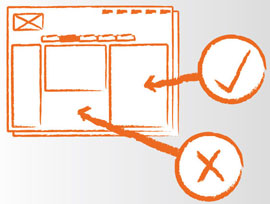Website accessibility and usability in a marketing perspective
Planning an effective website means designing it with characteristics which make it:
- accessible and easy to use, that is functional;
- effective and with a clear communication;
- graphically pleasing.
The number of online websites which are heavily lacking in one or more of these aspects is astonishing, but this very fact gives great opportunities to companies able to take advantage from competitor’s weakness on web usability.
This issue is even more relevant for eCommerce websites that need to make more intuitive and immediate the purchasing process to increase online sales.

Accessible and easily usable websites
A good website has always to be accessible, that is easily usable by anybody. Nowadays it means that a website should be surfable and smoothly usable with any kind of device: PC, tablet, mobile phone. Therefore it should be created a mobile version or, at least, a website provided with responsive design technology which makes it adapt to any screen resolution.
Visits to many websites through non-desktop devices are already above 30% of total traffic and will keep on growing. Websites unsuitable for small screens, especially when they require high levels of interaction, are strongly penalised.
Accessible websites are friendly with impaired users. Tag “alt” insertion, for example, allows to introduce an alternative text for images in order to help people with sight problems, using speach softwares, to access to all contents published. Alternative text serves also users who serf internet with textual browsers because of low bandwidth and troubles with images loading.
Information architecture, that is the way contents are organised, heavily impacts on website usability. Rich contents websites and online shops with dozens or hundreds of areas need informations to be organised and linked in a logic and intuitive fashion. Planning a clear hierarchy, which for each content area goes from general to particular, providing for users with a smooth access to all contents it is a fundamental goal to make a really accessible and usable website.

In order for the website to be entirely accessible by even the most naive user it is needed an efficient and easy to use navigation system. User experience is crucial for the success of any online marketing purpose.
Navigation menu to move through the website contents have to be smart, labels and links have to be studied and inserted strategically to value contents and satisfy search engines requirements (SEO).
Website usability and website effectiveness are not exactly the same
However it is not enough getting all web navigation funtions to work well. Besides allowing visitors to handly reach information a website must produce results. After being engaged, visitors should be called to produce an action which constitutes value for the company and that at the planning stage has been defined as business goal.
Converting visits in products and services sales, signups and contact requests, participation and active engagement, entails an accurate dedication to texts and visual communication. A good web design includes the insertion of effective images and baits, a punctual choice of buttons and “call to actions” messages.
Website usability is a paramount requirement, but it should be studied according to the business objectives that remain the final reference point. A perfectly accessible and usable website can be efficient but not effective if it does not turn visits into real value for the company which owns it.
Accessibility, graphic and design
There are countless websites with a beautiful well refined graphic which, nevertheless, would not pass a basic test in usability and accessibility. Many companies, confusing esthetic impact with effectiveness and functionality, find hard to recognise that their website does not go beyond a simple showcase function showing their activities to public.
In the worst cases from the lack, or low evidence, in website marketing results companies infer that online marketing and digital channels are not profitable and do not deserve further investments.
Fortunately, the industrial history comes to the aid with the design notion. This concept is not limited to the pure esthetic dimension of human artifacts but incorporates features of functionality, usability and ergonomy up to include style, communication and marketing values. In order for a website to be usable and effective it must be planned as a design product, complying at the same time with esthetic, functional and marketing requirements.
To give an example, since eye tracking researches, done while users are looking at a web page, show that the eyes focuse mainly on certain page areas or on particular elements which call attention, website planning or revision should always take these outcomes into account.
For the success of eCommerce online marketing these demands are even more binding: high amount of information, articulate procedures like shopping cart and payment process, the necessity for introducing both persuasive and reassuring elements and so on, push developers, designers and digital marketing specialists to a collective effort to create a website which embodies accessibility, usability and design values.
When the website is online it is possible to submit it to A/B and multivariate tests to compare web pages with different design, varying (based on clear hypothesis) even only minimal elements and analysing how they impact on user experience and conversions.
Web usability optimisation benefits a lot from monitoring data analysis. To this end it is important to get equipped with access tracking and web analytics tools.
Online marketing is an activity which starts at the beginning of the online identity construction and continues seamlessly with the resolute goal to produce value.
